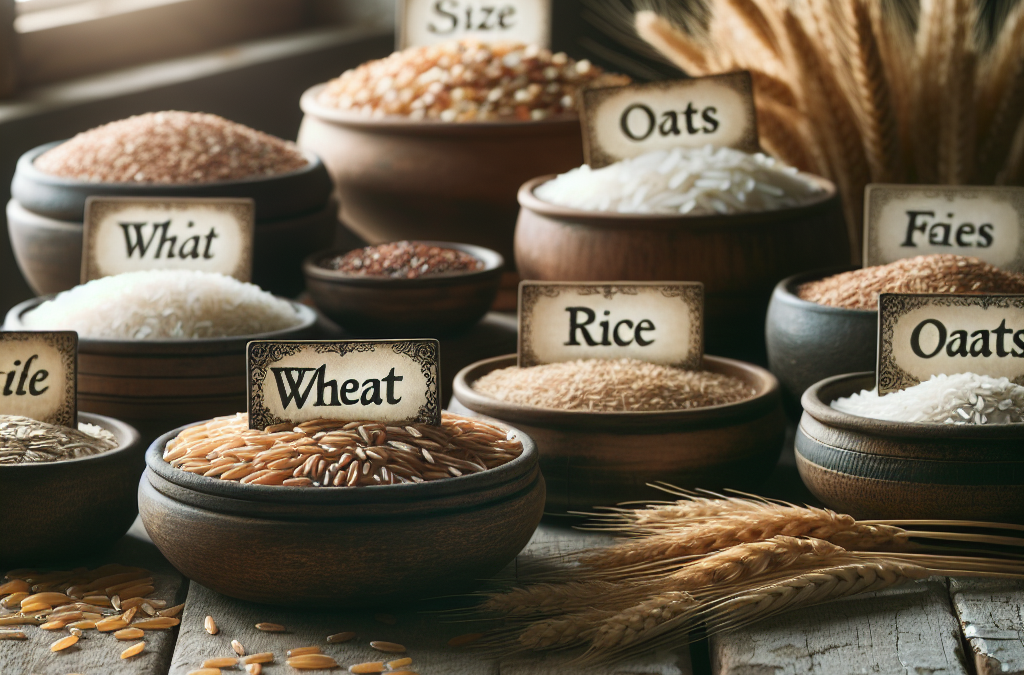Understanding Different Types of Grains
Whole Grains vs. Refined Grains
When choosing grains for storage, it’s crucial to differentiate between whole grains and refined grains. Whole grains include the entire kernel, consisting of the bran, germ, and endosperm. This means they retain more of their natural nutrients, making them a healthier option overall.
However, because they contain more oil due to the bran, whole grains may not store as long as their refined counterparts. In choosing grains, you’ll need to balance nutritional benefits with storage longevity. Refined grains, having been stripped of certain structures, tend to have a longer shelf life but are less nutritious.
When I select grains for my pantry, I often opt for a combination of both types. This strategy ensures I have options readily available that cater to both health and longevity needs.
Popular Grains for Storage
Another important factor is the type of grain itself. Some of the most popular grains for storage include rice, quinoa, oats, and wheat. Each offers different benefits and storage capacities. Rice, especially white rice, stores exceptionally well and is versatile in various dishes.
Quinoa, being high in protein, is a fantastic choice if you aim to maintain a balanced diet during emergencies. However, it can be pricier compared to other grains. Oats are great for breakfast meals and offer decent storage potential if sealed properly.
For me, wheat is a staple due to its flexibility in meal preparation. You can easily turn wheat into flour for baking, making it a useful grain to have in your stockpile.
Nutritional Value Considerations
Nutrition is always on my mind when I’m stocking up for the long haul. Whole grains typically hold more fibers, vitamins, and minerals than refined versions. It’s these nutrients that can make all the difference in diet sustainability when fresh produce isn’t available.
I recommend looking into the particular nutritional profiles of each grain type. Think about what you and your family need to meet daily nutritional requirements. Whole wheat, for instance, is rich in B vitamins which are essential for energy levels.
Remember, though, balance is key. While aiming for nutrition, don’t overlook grains that offer longevity, like polished rice. A well-rounded storage plan typically involves a mix of different grain types to cover all bases.
Assessing Storage Needs
Amount of Grain Needed
Before jumping into storing grains, it’s vital to assess how much you actually need. This depends on your household size and how often you consume grains. It’s usually practical to calculate your monthly consumption rate and then multiply that by the number of months you plan to store for.
For a typical family, I find that having a six-month supply of grains like rice or wheat can provide a comforting buffer during uncertain times. If you’re a fan of variety, adjusting these amounts for different grains will add diversity to your meals.
A practical tip: always start with a little more than you think you’d need. It gives peace of mind and room to tweak consumption if circumstances change.
Storage Space Evaluation
Space, or the lack thereof, can really dictate how much and what type of grains you can store. Consideration of storage area is one of the most significant aspects when planning your grain stockpiling. The space should be cool, dry, and dark to maximize grain shelf life.
A basement can be great for this if it’s not too damp, or you might use storage bins stacked in a pantry. Think about accessibility too—it’s no good storing grains where you can’t conveniently rotate them and check for spoilage.
In my home, I’ve found that using modular shelving helps efficiently organize and access my grain supply, maximizing the use of available space.
Budgeting for Your Grain Storage
Understanding your budget is pivotal when setting up your grain storage. While grains are generally affordable, costs can add up as you diversify and increase quantities. Budgeting helps you determine how much you can invest in grain stock at once.
It’s smart to start small and build up your grains inventory. This staged approach helps you manage your finances better and minimizes the risk of wastage from overstocking initially. Keep an eye out for bulk purchase discounts or sales to further stretch your budget.
From my experience, spreading purchases over time lessens the financial burden, making your stockpile more manageable and sustainable in the long run.
Identifying Suitable Storage Methods
Choosing the Right Containers
Picking the right containers for your grain storage is a game-changer. I personally swear by airtight containers as they work wonders in keeping grains fresh longer by preventing moisture and pest infiltration.
Mason jars, Mylar bags with oxygen absorbers, or commercial-grade buckets with gamma seals could be excellent choices. Each has its benefits depending on your storage layout and needs.
In our house, we stick to a combination approach. Bulk grains go into large buckets, while everyday use grains stay in easy-to-access mason jars. This balance keeps our grains fresh while minimizing the risk of spoilage.
Optimal Storage Conditions
Optimal storage conditions make all the difference in how long your grains will last. Temperature, humidity, and light exposure are key factors. Generally, the cooler the temperature, the longer the storage life for most grains.
I always keep grains out of direct sunlight and try to maintain a temperature below 60°F. Additionally, controlling humidity to stay below 15% can prevent spoilage from mold or pests.
Living in a variable climate, I use silica gel packs in my containers for extra peace of mind. These little tools effectively absorb residual moisture that might otherwise spoil the grains.
Pest Prevention Tips
If there’s one thing that can ruin your grain storage quickly, it’s pests. Tiny bugs can wreak havoc if you’re not careful. Every time I bring new grains home, I pop them into the freezer for a few days to kill off any potential insect eggs.
Once the freezing is done, transferring them to airtight containers helps keep pests at bay. It’s a simple trick but gives me peace of mind knowing I’m doing my best to keep my family’s food safe.
Additionally, always inspect your grain containers regularly. Catching any signs of infestation early helps you mitigate damage and save the rest of your food supply.
Determining the Shelf Life of Stored Grains
Factors Affecting Shelf Life
Understanding the shelf life of grains goes beyond just expiration dates; it’s affected by the type of grain, storage conditions, and the packaging used. Generally, refined grains like white rice can last for up to 30 years if stored properly!
Whole grains, conversely, may last for about 6-12 months due to their natural oils. Temperature fluctuations and humidity can also shorten grain life, so maintaining a controlled environment is crucial.
In my experience, knowing these factors allows for more informed decisions about stockpiling strategies, ensuring you’re not left with wasted supplies.
Signs of Spoilage
When storing grains, it’s essential to know the signs of spoiling. Bad odors, changes in color, or visible mold are significant indicators that the grains have gone off. Regularly checking your stock lets you catch these signs early.
I usually give my stored grains a quick sniff test every couple of months or so. If anything smells off, it’s best to dispose of it—for quality’s sake and to prevent contamination of other grains.
It’s also helpful to have a first-in, first-out (FIFO) system to use older grains first, reducing the likelihood of spoilage. This simple rotation strategy keeps my inventory fresh and safe to consume.
Extending the Shelf Life
Several methods can help extend the shelf life of your grains. Vacuum sealing your grains can significantly reduce air exposure, one of the leading causes of deterioration. It’s a technique I’ve relied on for years with great success.
Another practical tip is to store grains in a cool, dark environment. Consider using oxygen absorbers alongside Mylar bags to boost this effect, especially for long-term storage.
All in all, with the right techniques and vigilance, you can keep your grains fresh and ready to sustain your household for long periods.
FAQ
1. What are the best grains for long-term storage?
White rice and oats are excellent for long-term storage due to their longevity and nutritional value. These grains, when stored correctly, can offer sustenance in various meal preparations.
2. How do I prevent pests from getting into my grain storage?
Airtight containers and freezing new grains before storage are effective methods. Checking containers regularly for signs of pests can also help you prevent infestations.
3. How can I maximize the storage space for my grains?
Utilizing vertical storage solutions like shelving can dramatically increase your usable space. Labeling and organizing grains in stackable containers help streamline your storage area.
4. Why do whole grains have a shorter shelf life than refined grains?
Whole grains contain more natural oils in their bran, which can go rancid over time. This makes them more perishable compared to refined grains, which have these components removed.
Related Content
Auto Amazon Links: No products found.





